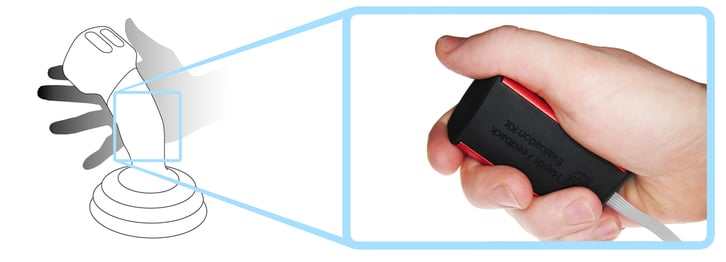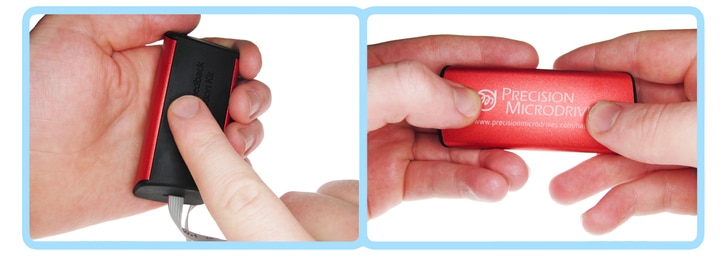Experience And Understand Haptics
Looking for our Haptics range? View our main Haptics hub here.
What Makes A Good Haptics Device?
Adding haptics or vibration alerting can improve the user experience and improve the performance of the operator/user.
As touchscreens become commonplace, the tactile feedback of a button press is lost. At times this left the user unsure if the device had received their input. This leads to a series of mistyping, double presses, and general mistakes when navigating the user interface.
Touchscreens are now even being introduced by car manufacturers. With the tactile feedback enabled dashboards, the touchscreen now vibrates to acknowledge an input from the user. Furthermore, different patterns are used to acknowledge different inputs and events. For example, when changing the sat nav’s route every keystroke is complimented with a short ‘click’ effect design to simulate a button press. However, moving an icon or widget on the home screen involves a ‘long press’ from the user and the dashboard responds with a different vibration pattern. Turning up the volume may be met with a series of short vibrations, each one stronger than the last.
This simple advancement reduces the user’s mistakes and typing errors, thereby reducing frustration and allowing them to marvel at their new technology. Things become really exciting with the progression of operating software and advanced apps placing more demand on high-performance haptics.
Consider what information you can transmit to your user, how it makes them safer, more efficient or increases productivity. Perhaps you’re looking to improve the customer experience and use haptic feedback as a competitive advantage. It’s also a great way of removing or augmenting other visual and audible alerts.
How Can I Experience Haptic / Tactile Feedback?
The most robust and application relevant way to experience tactile feedback and vibration alerting is to try our Haptic Feedback Evaluation Kit, available for $125. We have designed it specifically to be a cheap but accurate tool to simulate as many kinds of haptics and vibration alerting scenarios as possible.
The haptics evaluation kit makes it very easy to experience the cutting edge of haptics best practice. Our kit consists of two components; the ‘Haptic Controller’ which has a haptics-enabled capacitive touch user interface, and the ‘Haptic Grip’ which contains 4 vibration actuators, positioned and secured in various ways. The grip can be used to simulate many user interface paradigms, whilst the driver demonstrates touch-screen haptics. Haptic waveforms are based around a new cost-effective TI DRV2605 haptics processor which contains a fully-paid license to Immersion Corp (who own most haptics related IP).
The driver is an Arduino shield (Arduino Uno included) controlled by open-source software, which makes it an excellent haptics development and debugging tool as well. You can find out more about our haptics evaluation kit, and the vibration actuators contained within it on this page.
Once you are ready to move beyond the evaluation kit and would like to start prototyping and developing your own application, please follow our haptics guide and the following pages for detailed advice:
Chapter 1: An Introduction to Haptic Feedback
Chapter 2: Experience and Understand Haptics (this page)
Chapter 3: Adding and Improving Haptic Feedback
Chapter 4: Making a Haptic Device
Chapter 5: Precision Microdrives and Haptics
We have no minimum order quantity for most of our stock at Precision Microdrives, making it easy to test a variety of designs and actuators for a low cost. In addition, all of our vibration motors and LRAs are available at competitive prices in production quantities (1k ~ 100k+ pcs) so you can rely on our expert support throughout the product’s design cycle and production.
What Products Can The Evaluation Kit Simulate?
The evaluation kit will comprise of a controller and a grip. The driver has a small capacitive touch surface with an LRA actuator that can simulate touch-screens and capacitive control panels. Meanwhile, the grip has been designed to simulate as many generic product forms as possible.
The grip can be held in a number of ways to simulate products such as scanners & tools, control-sticks, handheld instruments such as gas monitors and mobile phones, and body worn devices such as radios and environment detectors.
Below are a couple of example products that could benefit from haptic feedback – and a demonstration for how the evaluation kit can simulate them.
Security Scanner / Tool
We’ve spoken before about how security scanners could benefit from tactile feedback, as it can replace or augment the existing audible alerts. There is also the opportunity for discreet alerting if desired, to increase the safety of the guards. The grip of our evaluation kit can be used to simulate a round handheld product or similar device.
Protective clothing such as gloves will affect how well the haptics and vibration alerting work. The freedom of the grip allows you to experience (by rotating a switch) how sized different vibration actuators and haptic waveforms would feel depending upon orientation, position, hold and clothing.
Similarly, barcode and RFID scanners, digital torque wrenches, and a variety of other handheld products are held in this way and can be imitated.
Industrial Equipment Control Stick
In loud and distracting environments, haptic feedback can be a great augmentation to existing visual/audible indicators when communicating with the operator. As many industrial vehicles and control panels have a joystick, this makes an ideal location for mounting. Haptic feedback based upon loading balances, or the vehicle’s spatial awareness (similar to parking sensors) improves the performance of the operator whilst making the site safer.
The haptic grip is designed such that it feels natural to hold it as a joystick. In fact, most will pick up the grip like this automatically. Try it out with protective gloves to simulate real-world use and note how lower frequency vibrations attenuate less.
Handheld Instrument (E.G. Mobile Phone Or Gas Monitor)
Handheld devices that offer information on a display are usually cradled to avoid covering up the display. Gas monitors or mobile communication devices may present important information on the screen, so the user would typically hold the device with an open grip. This is particularly true for products that use touchscreens, as the user may be required to input information. Consider a device that helps medical professionals administer drugs, the device could both accept the input from the user (thereby logging the information for patient records) and provide haptic feedback when the drug had been administered.
Capacitive Touch Surface / Screen
Many capacitive touchscreens are mounted to act as the user interface for much larger devices, such as washing machines or microwaves. Here the user is typically receiving haptic feedback as a confirmation of their input.
The driver section of the evaluation kit simulates this perfectly, as the user enters information through the capacitive buttons and the LRA mounted behind the shield vibrates accordingly. With the LED display guiding users through the software, users receive both visual and physical confirmation as they navigate the menus and options.

Get in touch
Speak to a member of our team.
Motor catalogue
Looking for our products?
Reliable, cost-effective miniature mechanisms and motors that meet your application demands.

 Evaluation kit as a scanner/tool
Evaluation kit as a scanner/tool
 Evaluation kit as a handheld instrument
Evaluation kit as a handheld instrument Evaluation kit as a capacitive touchscreen
Evaluation kit as a capacitive touchscreenNewsletter
Sign up to receive new blogs, case studies and resources – directly to your inbox.

Sign up
Discover More
Resources & Guides
Discover our product application notes, design guides, news and case studies.
Case Studies
Explore our collection of case studies, examples of our products in a range of applications.
Precision Microdrives
Whether you need a motor component, or a fully validated and tested complex mechanism – we’re here to help. Find out more about our company.